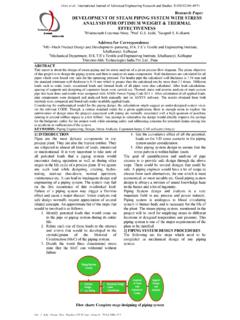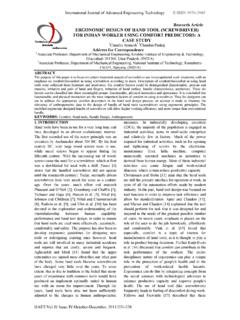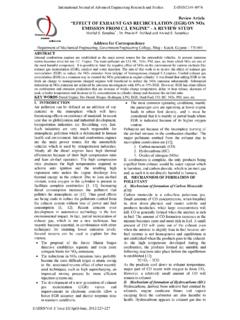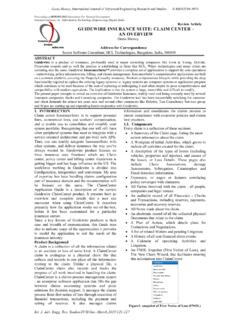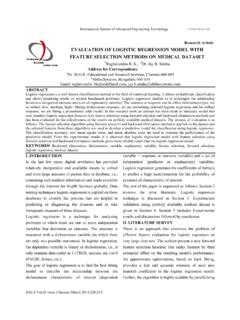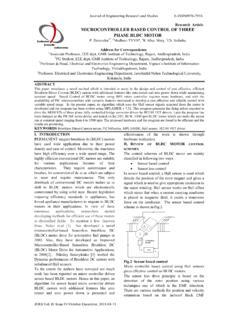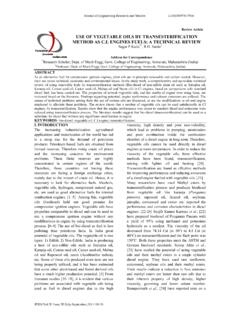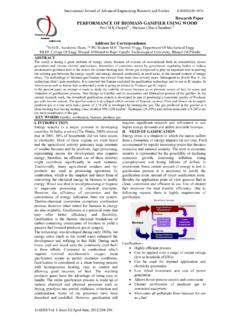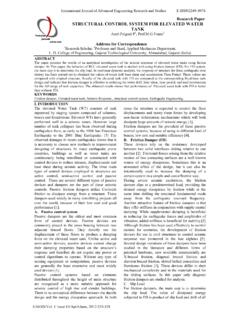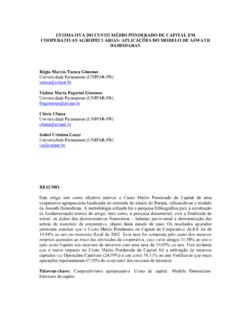Transcription of Review Article EFFECT ON CONCRETE BY …
1 Kholia et al., International Journal of Advanced Engineering Technology E-ISSN 0976-3945 IJAET/Vol. IV/ Issue II/April-June, 2013/57-60 Review Article EFFECT ON CONCRETE BY DIFFERENT CURING METHOD AND EFFICIENCY OF CURING COMPOUNDS A Review Nirav R Kholia, Prof. Binita A Vyas, Prof. T. G. Tank Address for Correspondence Student, Professor, Engineering College, Ahmedabad 3 Professor, Pandit Din Dayal petroleum university, Gandhinagar ABSTRACT The properties of hardened CONCRETE , especially the durability, are greatly influenced by curing since it has a remarkable EFFECT on the hydration of the cement.
2 The advancements in the construction and chemical industry have paved way for the development of the new curing techniques and construction chemicals such as Membrane curing compounds, Self-curing agents, Wrapped curing, Accelerators, Water proofing compounds etc. With the growing scale of the project conventional curing methods have proven to be a costly affair as there are many practical issues and they have been replaced by Membrane curing compounds and Self-curing agents up to some extent as they can be used in inaccessible areas, Vertical structures, Water scarce areas etc.
3 It is most practical and widely used curing method. In this Review paper effort has been made to understand the working and efficiency of curing methods which are generally adopted in the construction industry and compared with the conventional water curing method. KEY WORDS: Curing Compounds, Self-Curing agents, Wrapped Curing, Hardened Properties, Durability, Curing Efficiency. INTRODUCTION: Curing is the name given to the procedures used for promoting the hydration of the cement, and consists of a control of temperature and of moisture movement from and into the CONCRETE .
4 Curing allows continuous hydration of cement and consequently continuous gain in the strength, once curing stops strength gain of the CONCRETE also stops. Proper moisture conditions are critical because the hydration of the cement virtually ceases when the relative humidity within the capillaries drops below 80% [1]. With insufficient water, the hydration will not proceed and the resulting CONCRETE may not possess the desirable strength and impermeability. The continuous pore structure formed on the near surface may allow the ingress of deleterious agents and would cause various durability problems.
5 Moreover due to early drying of the CONCRETE micro-cracks or shrinkage cracks would develop on surface of the CONCRETE [2]. When CONCRETE is exposed to the environment evaporation of water takes place and loss of moisture will reduce the initial water cement ratio which will result in the incomplete hydration of the cement and hence lowering the quality of the CONCRETE . Various factors such as wind velocity, relative humidity, atmospheric temperature, water cement ratio of the mix and type of the cement used in the mix. Evaporation in the initial stage leads to plastic shrinkage cracking and at the final stage of setting it leads to drying shrinkage cracking.
6 Curing temperature is one of the major factors that affect the strength development rate. At elevated temperature ordinary CONCRETE losses its strength due to the formation of the cracks between two thermally incompatible ingredients, cement paste and aggregates. When CONCRETE is cured at high temperature normally develops higher early strength than CONCRETE produced and cured at lower temperature, but strength is generally lowered at 28 days and later stage [3]. A uniform temperature should be maintained through the CONCRETE section to avoid thermal cracking.
7 Laboratory tests show that CONCRETE in dry environment can lose as much as 50 percent of its potential strength compared to similar CONCRETE that is moist cured. Curing of the CONCRETE is also governed by the moist-curing period, longer the moist-curing period higher the strength of the CONCRETE assuming that the hydration of the cement particles will go on. American CONCRETE Institute (ACI) Committee 301 recommends a minimum curing period corresponding to CONCRETE attaining 70% of the specified compressive strength [4]. Curing has a strong influence on the properties of hardened CONCRETE ; proper curing will increase the durability, strength, volume stability, abrasion resistance, impermeability and resistance to freezing and thawing [5].
8 A durable CONCRETE is one that performs satisfactorily under the anticipated exposure condition during its designed service life. In addition to the normal CONCRETE mix some additional compounds in proper dosage and materials such as fly ash are used to increase the durability and strength of the CONCRETE mix. Curing techniques and curing duration significantly affects curing efficiency Various degree of efficiency can be achieved by various in situ-curing methods. The effectiveness of the CONCRETE curing method depends on the material used, method of construction and the intended use of the hardened CONCRETE .
9 Techniques used in CONCRETE curing are mainly divided into two groups namely, Water adding techniques and Water- retraining techniques. Reliability and effectiveness of such curing methods are still under debate. This study presents the working comparison and the effectiveness of curing methods on several hardened properties of CONCRETE such as compressive strength, flexural strength, initial surface absorption, ultrasonic pulse velocity and dynamic modulus of elasticity. Review OF LITERATURE: Dry-Air Curing: Dry curing is a curing method wherein the CONCRETE cubes are left in open air to be cured at room temperature.
10 Researchers have been working on the natural air drying of CONCRETE since long. Md. Safiuddin et al [6] carried out experiments to study the EFFECT of this type of curing on the properties of Microsilica CONCRETE (Microsilica was used as a 10% weight replacement of cement) with a water binder ratio of Dry-air curing produced , and reduction in compressive strength, dynamic modulus of elasticity and ultrasonic pulse velocity respectively, this was owing to the early Kholia et al., International Journal of Advanced Engineering Technology E-ISSN 0976-3945 IJAET/Vol.
